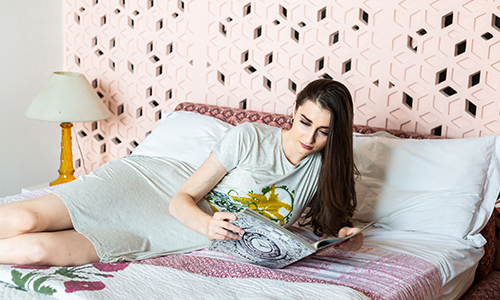You might have read a lot about how lingerie can improve mental health and what to wear at night, but this blog gives you a deeper understanding of what happens to your body during sleep. Ever wondered about the relationship between your nightwear and peaceful sleep? Yes, it plays a major role in ensuring restful sleep. Night clothes primarily alter the thermal temperature by providing insulation, trapping body heat and creating a warmer microclimate around the skin.
How Does Our Body Maintain Thermal Comfort During Sleep?
The thermal environment is an important factor that affects human sleep. For example, when you feel sleepy, there is a decrease in core body temperature and an increase in skin temperature. The core body temperature continues to decrease throughout the night while the skin temperature remains high. The core body temperature rises only when you wake up. Room temperature, humidity, air speed, nightwear, and weather influence the thermal environment. Exposure to chillness increases sleeping difficulty because the body struggles to maintain thermal comfort.
So, what's the solution?
Clothing and bedding insulate the body and regulate the temperature. A theoretical study on thermal comfort proves that sleepwear and bedding maintain a proper thermal environment.
How Does the Fabric of Nightwear Affect Thermal Comfort?

Natural fabrics such as cotton and wool and artificial fabrics like polyester and nylon are used for sleepwear and bedding. The difference in the properties of every fabric has a different effect on thermal insulation. Fabrics have insulation properties that influence thermal comfort. It regulates heat and moisture transfer between the skin and the environment.
Cotton and wool have the ability to absorb and transfer large quantities of moisture. Wool absorbs 35% moisture, cotton 24% and polyester below 1%. Wool has the highest moisture-recovery level, while polyester has the lowest. Cotton has an intermediate recovery level.
Breathable, moisture-wicking natural fibers like cotton and linen are ideal for warm climates, while insulating fabrics like wool are better suited for colder conditions.

In addition, poor sleepers have less wakefulness when sleeping in wool and cotton. The rate of rapid eye movement sleep is higher in polyester than in cotton or wool. Thus, natural fabrics like wool and cotton are the best choices for nightwear.
How to Improve Your Sleep Quality?
Wear Cotton
Cotton is the best material for sleeping. It is ideal because it is a natural fibre, lightweight, soft, and comfortable and allows your skin to breathe and will improve sleep quality. It also helps maintain the thermal comfort zone.
Wear Loose Clothing

Wearing loose clothing can help your skin breathe by regulating blood circulation. Tight clothing with tight elastic bands can have a negative impact on your sleep. Wearing a good cotton gown, a relaxed-fit pyjama set helps you maintain good thermal comfort and improves sleep quality.
Find the Right Alternative Fabric

If wearing cotton doesn't align with your personality, you may choose other good fabrics. Pick lace, mesh, satin, bamboo, viscose, and modal nightwear that are comfortable. Always choose a fabric that helps you regulate your body temperature throughout the night.
Dress Right at Night

A good night's sleep plays a vital role in your health and well-being. While it is important to dress up during the daytime, it is equally important to dress right at night. as it can make a big difference in sleep quality.
Should You Wear a Bra While Sleeping?

While we are talking about nightwear/sleepwear, let’s not forget bras. Should you wear a bra to bed? The decision is all yours. Wearing a bra while sleeping is totally up to the individual’s personal choice. There are also sleep bras specifically designed for an uninterrupted, peaceful slumber.
Final Words,
Sleep is incredibly important, and no one rule works for everyone. Find what's best and most comfortable for you to enjoy your sleep. We hope this blog helps you understand the importance of investing in good nightwear.
Author Note: I’d like to thank Dr. Zhongping Lin and Dr. Shiming Deng for their informative research on thermal comfort in sleeping environment. I’ve shared their research findings in this blog for informational purpose.

